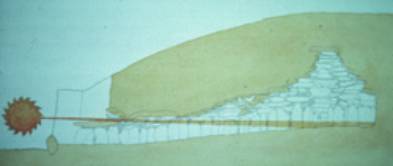





Newgrange is not so much a pyramid as it is a large mound. It was originally built c. 3200 BC according to the most reliable Carbon 14 dates available, this makes it more than 500 years older than the Great Pyramid of Giza in Egypt, and predates Stonehenge trilithons by about 1,000 years, (the earliest stages of Stonehenge are roughly contemporary with Newgrange).
Although it was built thousands of years ago, it lay lost for over 4,000 years due to mound slippage, until the late 17th century, when men looking for building stone uncovered it, and described it as a cave.
Newgrange was excavated and much restored between 1962 and 1975, under the supervision of Prof Michael J O'Kelly, Dept. of Archaeology, University College, Cork. It consists of a vast man-made stone and turf mound retained within a circle 97 large kerbstones topped by a high inward-leaning wall of white quartz and granite.
Most of the stones were sourced locally (within a radius of 20km or so) but the quartz and granite stones of the facade must have been sourced further afield, most probably in Wicklow and Dundalk bay respectively.
Within the mound, a long passage, only going in one third of the length of the mound, leads to a cruciform (cross-shaped) chamber. The passage itself is over 60 feet (18m). The burial chamber has a corbelled roof which rises steeply upwards to a height of nearly 20 feet (6m). A tribute to its builders, the roof has remained essentially intact and waterproof for over 5,000 years.Newgrange appears to have been built as a tomb.
The recesses in the cruciform chamber hold large stone basins into which were placed the cremated remains of those being laid to rest. During excavation, the remains of only five individuals were found. It is speculated that the sun formed an important part of the religious beliefs of the New Stone Age people who built it.
Formerly the mound was encircled by an outer ring of immense standing stones, of which there are twelve of a possible thirty seven remaining. However, it seems that the stone circle which encirlced Newgrange are not contemporary with the monument itself but were placed there some 1,000 years later in the Bronze Age.
Every year, at the time of the winter solstice, the sun shines directly along this passage into the chamber for about 17 minutes as it rises. The alignment with the sun is too precise to have occurred by chance.The sun however, does not enter the passage at Newgrange through the main entrance, but rather through a specially contrived opening, known as a roofbox, which lies directly above the entrance. Although solar alignments are not uncommon among passage graves, Newgrange is essentially the only one said to contain the additional roofbox feature. The solar alignment at Newgrange is also still very precise compared to similar phenomena at other passage graves such as Dowth or Maes Howe in the Orkney islands off the coast of Scotland.
Spiral and lozenge motifs engraved on the magnificent entrance slab, "one of the most famous stones in the entire repertory of megalithic art" include a triple spiral motif, found only at Newgrange and repeated along the passage and again inside the chamber, are reminiscent of the triskelion motif of the Isle of Man, of ancient Sicily and of several passage tombs on the island of Anglesey in North Wales. There are further examples of megalithic art on many other kerbstones at Newgrange (notably Kerbstone 52 and 67). However the majority of the megalithic art in the Bru na Boinne complex is located at Newgrange's sister tomb of Knowth.
Near Newgrange are many other passage tombs, the largest being Knowth, and another significant tomb; Dowth. These tombs are all contemporaryy with Newgrange and together they and their 37 smaller satellite tombs form the Bru na Boinne complex. Newgrange